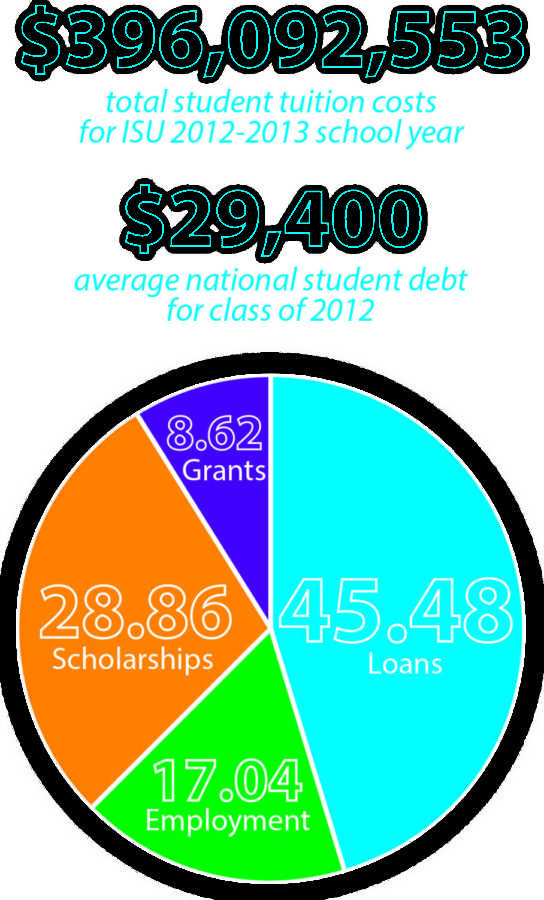Iowa Board of Regents considers performance-based funding
By Emily Hecht/Iowa State Daily
This graph shows the total Iowa State University student population. The individual numbers indicate percentages in the ways in which the total tuition is paid. Nearly 46 percent of students pay their tuition through student loans, less than 30 percent pay it with scholarships, just more than 17 percent use money earned at a job and less than 10 percent is through grants.
January 17, 2014
The Iowa Board of Regents is looking into the models of higher education funding.
The Performance-Based Revenue Task Force, created in April by earlier Regent President Craig Lang, was directed to examine the existing model for general university appropriations “to ensure that the needs of the universities are met, to recognize their distinct missions and to identify the right set of metrics to review performance,” a notice from the board office said.
Iowa State receives tuition revenue, donations and state appropriations. Appropriation is segregated between the three regent universities, Iowa State University, University of Iowa and University of Northern Iowa in a 40-40-20 ratio. As in, 40 percent of funds goes to Iowa State, 40 percent goes to Iowa and 20 percent for UNI.
“Mostly, it has been distributed that way based on population,” said Roberta Johnson, director of financial aid. “Iowa State and Iowa historically have been pretty close in terms of overall enrollment.”
Performance-based funding is a system that allocates a portion of a state’s higher education budget, according to an institution’s specific performance measures, instead of basing funding entirely on enrollment numbers.
Janice Friedel, associate professor in the school of education, worked with the Education Policy Center at the University of Alabama on a national study about performance-based funding.
“Administration has been really advancing the need for colleges to measure their success and for states to tie their funding not so much to enrollment, but to the outcomes of the system in terms of credentials, degrees and skills and knowledge graduates have when they leave the institution,” Friedel said.
Additional metrics performance-based funding looks at include retention rates, Pell grant recipients, first generation students, how an institution benefits the local area, program completion and how students’ jobs impact the economy upon graduation. Because of so many credentials, Friedel said each state differs in how they would make their performance policies.
Johnson said questions have been raised as to why students in Iowa have as much debt as they do. As a state, Iowa ranks number six in the nation in terms of students being in the most debt upon graduation, Johnson said, though Iowa State has been holding debt steadily.
“[Performance-based funding] is a way to provide information to them as they formulate the idea in terms of how the dollars might be distributed,” Johnson said. “Is there something that they should or should not be thinking about in order to not negatively impact students so that they would end up having to borrow more money?”
Friedel said performance-based funding is not a solution to high tuition rates and said there is not significant evidence to show this method has resulted in increased institution outcomes.
“Performance-based funding cannot solve the problem with reduced state support in colleges and universities,” Friedel said. “Performance-based funding is not the solution to high tuition costs. [It] ties funding to specific outcomes that you measure and colleges typically compete for those additional funds.”
Friedel will give a presentation to the task force at their next meeting on Jan. 21 at the board office in Urbandale, Iowa. She said the presentation will look at national patterns in performance-based funding. She will share what research shows the advantages, disadvantages, advice and recommendations with the board.
Check back with the Iowa State Daily with more information on performance-based funding in Iowa.







